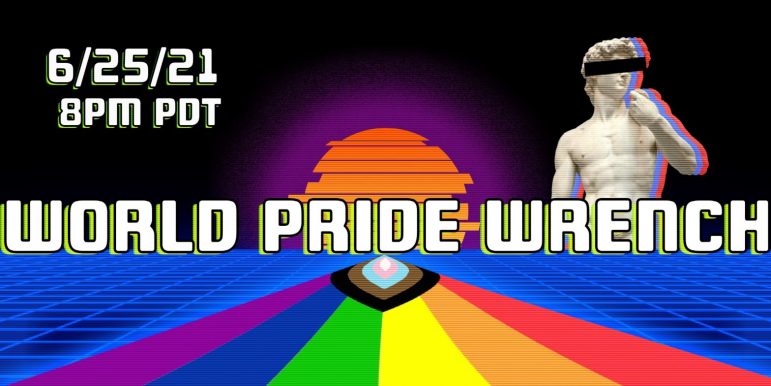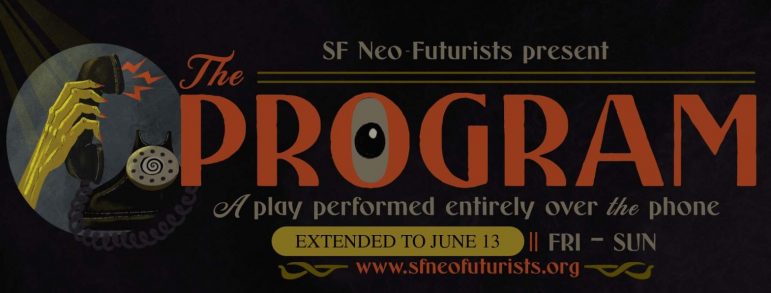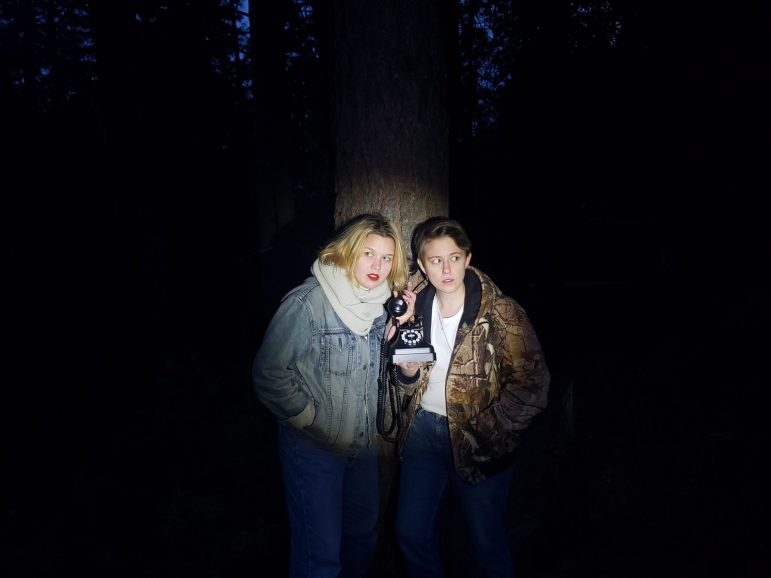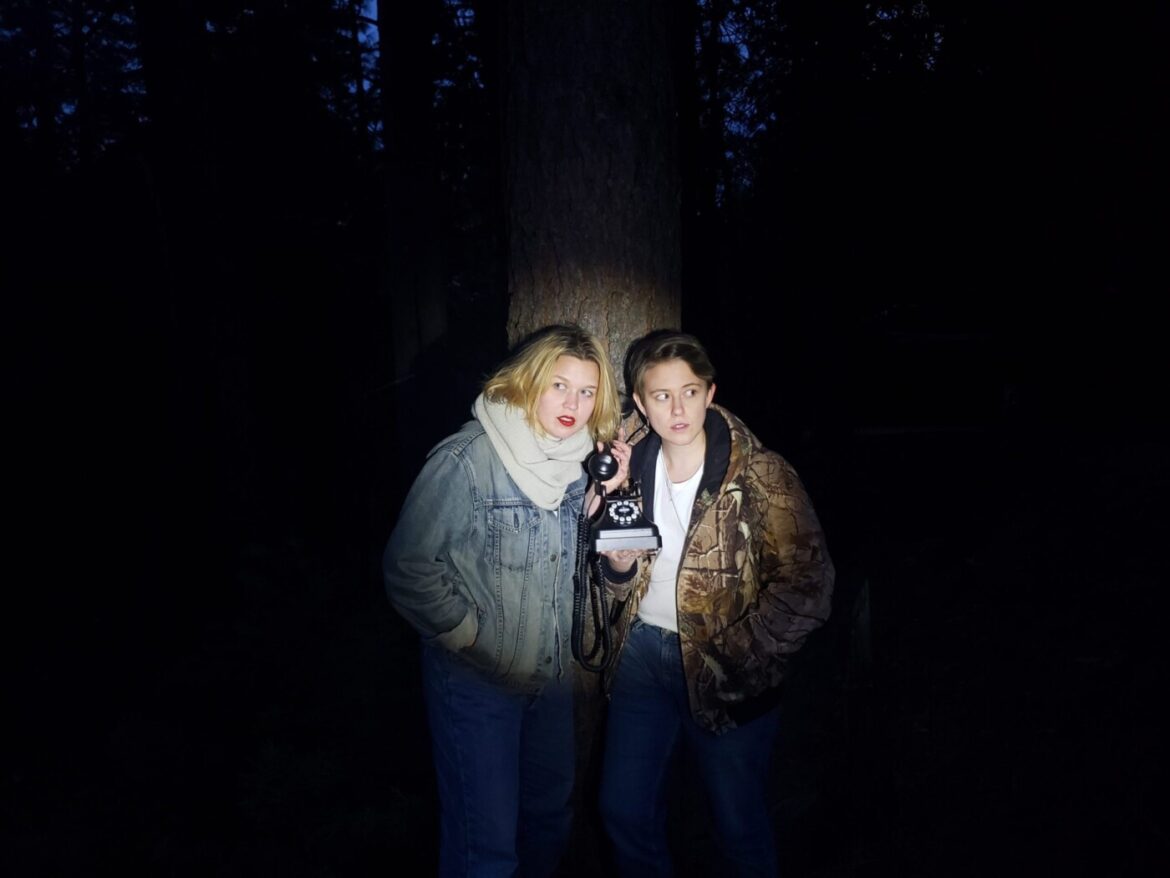If there’s one thing you can say for fans of the SF Neo-Futurists, it’s that they’re loyal.
When shelter-in-place orders first sprung up last March, the San Francisco chapter of the famed experimental theater troupe (with its founding chapter in Chicago, and additional chapters in New York and London) was one of the first companies to stop performing. This prematurely ended their PianoFight-based show, “The Infinite Wrench.”
As with every other form of entertainment, the SF Neos went online. Adapting the Neo-Futurists’ format — a race to finish 30 sketch-like performance art pieces in random order before the 60-minute clock runs out — for the internet was no short order; it meant jettisoning such company mainstays as post-show pizza with the audience, deciding the walk-up ticket price from a literal roll of the dice and any piece that required direct audience participation.

Fortunately, audiences were all too eager to discover the ensemble’s online redux, “The World Wide Wrench.” Beginning with a weekly show that incorporated prerecorded segments and livestreamed performances, the now-monthly show consists of more live material. As one would guess, it primarily sees the ensemble’s writer-performers reacting to a planet forced inside and online for 15 months-and-counting. The simultaneous agony and ecstasy of pandemic life was their meal du jour, and the digital format has only increased the size of their audience.
What’s more, they continue to experiment: This May saw the premiere of “The Program,” an interactive experience taking place entirely over the phone. Conceived by company members Amy Langer and Ezra Reaves, it puts paying audience members in the middle of a 45-minute experimental performance that finds them interacting with an automated phone system programmed and written by the company. Despite numerous slots over several weekend days, reservations have been selling quickly, requiring the company to (as of this writing) extend to June 13.
If you’re curious as to how an automated-phone show fits into the aesthetic of a performing arts troupe, I put that very question to company members when I reached out to them recently. I spoke to artistic director Margaret McCarthy, “Program” co-creator Langer and writer-performer Tonya Narvaez about the new show, experimenting online and the future of live performance in San Francisco.

Having now done a year of “World Wide Wrench” online, is there anything in particular you’ve come to love about the digital-only format, even if just by Stockholm Syndrome?
Margaret McCarthy: Far and away, what I love most about the digital format is that it’s expanded access for both performers and for [the] audience. We have audience members tuning in from different parts of the country — and sometimes the globe! — which is incredible. And ditto [the] ensemble: We’ve had guest artists participate virtually from New York, Chicago, L.A. and New Zealand. We also have ensemble members and alums who are parents of young children and wouldn’t be able to perform in the live show, but they’ve been able to make video art from home on their own schedule. Being able to keep connected with our company members who are also raising babies, and for them to have a more accessible venue for art-making, feels pretty incredible.
Tonya Narvaez: I love the passionate community we’ve continued to share our work with. […] We switched to a live digital format this year with a chat room (AOL Instant Messenger-style) for folks to chat before/during/after the show, and I think it’s really helped us feel together. I treasure being able to interact and react with everyone in real-time.
The usual in-person SF Neos shows had the option of a ticket price decided by dice. Have you done a similar “admissions-roulette” for online patrons?
McCarthy: When shelter-in-place started, a few things became immediately clear to us: We wanted to keep making art; and we really wanted to keep it accessible. When we do our in-person show, tickets range from $14-$20 (with $10 tix available to local artists), but the crisis of unemployment caused by COVID was immediately apparent to our ensemble, so we decided to offer our show for free. We now offer tickets on a sliding scale, but the scale starts at $0. Since we know so many people are struggling and there just isn’t enough government support available, it’s been important to us that financial constraint not be a barrier in seeing the show. We are eternally grateful to our donors and Patreon supporters, who have enabled us to continue paying our ensemble at pre-pandemic rates while offering the show for free.

After a year, what’s been the completion average for a “WWW” show — do they often get through the full 30? How does it compare to previous in-person averages?
McCarthy: Well, sometimes yes, sometimes no — just like live [shows] — but we’re on, at least, our second digital show model at this point, so we don’t really have a year’s worth of data. In 2021, we shifted from creating new virtual art weekly with only periodic live components to a monthly livestreamed show with both live and prerecorded components. Ironically, it’s a lot more work to create work digitally, so while we miss the weekly pace, we’re loving the monthly livestream format because we’re able to have real interactions with the audience. We have a lot of ways to engage the audience: [There’s] a live chat [that] runs throughout the show, the audience selects the order of the show by clicking on the play number — thanks to a custom website built by ensemble member and my co-artistic director Topher Lin — and we sometimes pull an audience member-volunteer on camera via a secret link. It’s pretty cool!
The SF Neos infamously ask a lot of their performers (most potential ensemble members never make it through the tough audition stage), and your work, Tonya, has always been particularly frank. Has it led to any unexpected revelations over the course of performing the show online for over a year?
Narvaez: I think the biggest thing we realized together was that everyone is tired, and that’s OK. In 2020, we continued the weekly cadence for the show, which felt good and important to many of us early on. We discussed how things felt throughout the year and agreed we should sit down and hone in on our collective needs and limitations so we could continue the show in 2021 in a way that served us and our community more meaningfully. So, the weekly “World Wide Wrench” was replaced with a monthly “World Wide Wrench” that happened live.
Would you be up for continuing the online version in the future or are you ready to return to live performance?
Narvaez: There are things I love about digital work that are trickier to translate live. Like plays involving websites, whispering, tiny objects, special effects, etc. But as soon as it’s safe, I’m ready to get back to live performance. That said, “The Program” is the company’s first prime-time (full-length) show. Without rent to pay, we kept costs relatively low while still paying artists, so I personally believe there’s room for more creative use of digital work in the future — as long as it feels relevant and worthwhile.

That leads to the next question: Who came up with the idea for “The Program”?
McCarthy: All credit to our amazing ensemble members Amy Langer [she/her] and Ezra Reaves [they/them]!
Amy Langer: “The Program” started as a two-minute play, written by Ezra for “The Infinite Wrench.” I absolutely love the piece. It’s Ezra at their finest: eerie, tongue-in-cheek and very, very funny!
When we transitioned to a digital show, both Ezra and I started experimenting with phone-based work as a way to reach people remotely. I made “The Screaming Into the Abyss Helpline” and “The Queer Fantasy Line,” while Ezra built out the first phone version of “The Program,” based on the original stage performance. All of these pieces were built out on Twilio, a software platform usually used by corporations to make automated phone trees. Turns out, it’s pretty fun to play around with for decidedly non-corporate business!
In late 2020, Ezra and I started talking about making a full-length phone version of “The Program,” taking the themes and aesthetics that Ezra had started with, and spinning them out into a larger story about the desire for connection amid a world of increasing automation and chaos; something a little Beckett, a little Lynch and a little Portal [the video game].
Even by the evolving standards of COVID-era performance, an entirely phone-based, one-on-one performance is unorthodox. What has the reception been from audiences thus far?
Langer: I’ve been really charmed by the audience reaction to “The Program.” I’m a firm believer that the medium is the message. Part of what I love about making work for the phone is that there’s a certain perceived intimacy to listening to a voice on the other end of the line. There’s a natural ache to it: a desire to be close, hampered by physical distance. Sure, we have jokes, and levity, and audio soundscapes, but the heart of “The Program” reflects this ache.
While running beta tests with our friends, a number of folks told me how affected they were by the piece, given that they spent the past year dealing with distance: being told to just hold for a little longer, while waiting to be held.

How does an experience revolving around automated phone calls work with the SF Neos’ performance art aesthetic?
Langer: I’ve been a member of the SF Neo-Futurists for almost eight years. The reason I’m still around (in addition to being constantly amazed by the work that folks bring in) is that our practice stretches out the conventions of theater, partially by virtue of needing to convey a feeling in a short amount of time.
As someone who has spent a lot of time on automated phone trees this past year — cancelling flights, figuring out EDD, navigating appointments — it was clear that there was a certain, let’s say, emotional charge to dealing with a seemingly endless automated system, especially when you only wanted to talk to a real, actual person. So, in the same way that a sound cue or lighting change might help audiences access a feeling during a stage play, “The Program” uses an automated phone system to create an immersive, emotional experience for audience members that turns their house into the stage.
Are you part of “The Program,” too, Tonya?
Narvaez: I am! During the ensemble readings, I did utilize my previous experience in customer support at startups to give a little bit more of that language. You know, the professional, warm-yet-robotic, non-confrontational language you hear when you call a company for anything. Just for one specific section. Amy and Ezra did an amazing job writing — I only suggested one or two sentences of the script.
Is it possible for someone hearing-impaired to take part?
Langer: At this point, “The Program” is an entirely auditory experience. However, accessibility is definitely on the forefront of our minds; Ezra and I spent a great deal of time talking about how having a phone-based play could allow audience members to join us who are otherwise unable to attend our usual live show. One of the lovely things about “The Program” is that it invites iteration. I could very well imagine a future where (with a little funding) it exists as a text-based chatbot, thus allowing even a greater number of individuals to access the show.
So, you see this type of performance becoming a regular thing?
Langer: Whenever you have a couple of Neo-Futurists together, we’re going to start brainstorming ways to experiment with form! I have a feeling that, in the future, we’ll still opt to do the majority of our experimentation from the stage. But I do think that one of the lessons we’ll roll forward is that the stage needn’t always be the default.
Ezra and I wrote, programmed and tested “The Program” in about 10 weeks. We’ve learned so much during this time, both in terms of what Twilio might allow for future projects and what future edits we might make if “The Program” is remounted in the future. We’re also planning some new immersive projects that will definitely be a little more traditional than a phone play, but which will continue to question what technologies can help support the stories we want to tell.

As San Francisco slowly moves toward reopening in June, have the SF Neos made plans for a return to live performance? And, if so, will you still perform at PianoFight?
McCarthy: We are in ongoing communication with PianoFight. We really, really miss being live and interacting with our audience in person, [but] we are deeply committed to audience and performer safety. We were one of the first local theater companies to close, and we want to make sure when we reopen that we’re able to do so in a way that both feels safe and is safe. We love PianoFight, and we plan to be back there when we do return to the stage.
As a performer, Tonya, are you comfortable with a reintegration of live audiences?
Narvaez: I’m personally unsure what my comfort level is. I’m excited, but also optimistic-yet-vigilant? I feel it kind of depends on how things continue to shake out this summer.
Is there a live show you’re looking forward to?
Narvaez: I am mostly just looking forward to in-person shows being safe in general, so we can again have common physical spaces for our communities to exist in. I’ll be deeply happy if I can: Wake up one morning; decide to see a local show; get a Donna [Fujita] hug at The Exit or listen to Max Chanowitz play at PianoFight beforehand; run into old friends; make some new ones; and return home feeling fuller.
Aside from an obvious period of adjustment, what does the post-pandemic future of the SF Neos look like for you?
Narvaez: I’m looking forward to having auditions eventually, to bring in new people with new ideas and new perspectives. I don’t know how long I’ll be an active ensemble member, but for now I feel ready to continue pressing onward and seeing how else we can grow as a company and as individual artists.
McCarthy: Honestly, I don’t know what “post-pandemic” means. I think we will all continue to experience the ramifications of this pandemic for a very long time. But in terms of returning to live performance, we’re eager to be able to offer our brand of unique, chaotic, short-form theater to local audiences live again.

“The World Wide Wrench” streams online the final Friday of each month at 7 p.m. Admission runs on a sliding scale of $0-$20. “The Program’s” extended run (via telephone) is scheduled to last until June 13. The 45-minute experience requires a reservation, and available times run from 5 p.m.-9 p.m. on Fridays and Saturdays, 3 p.m.-9 p.m. on Sundays. Access and information on the company and both shows can be found at https://www.sfneofuturists.org/.
